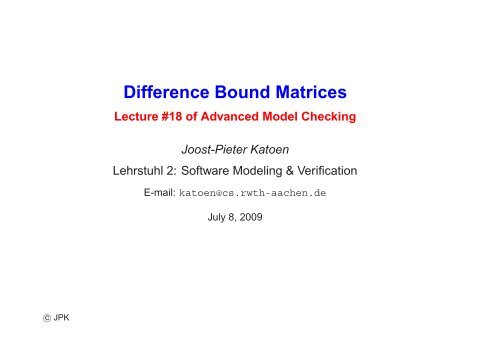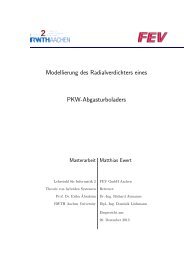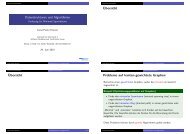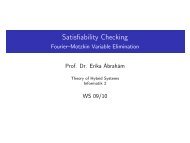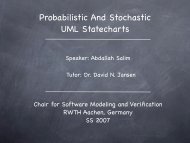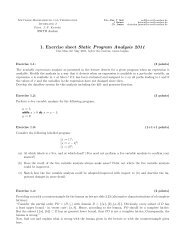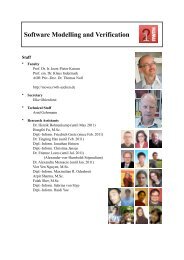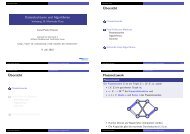Difference Bound Matrices - Software Modeling and Verification
Difference Bound Matrices - Software Modeling and Verification
Difference Bound Matrices - Software Modeling and Verification
Create successful ePaper yourself
Turn your PDF publications into a flip-book with our unique Google optimized e-Paper software.
c○ JPK<br />
<strong>Difference</strong> <strong>Bound</strong> <strong>Matrices</strong><br />
Lecture #18 of Advanced Model Checking<br />
Joost-Pieter Katoen<br />
Lehrstuhl 2: <strong>Software</strong> <strong>Modeling</strong> & <strong>Verification</strong><br />
E-mail: katoen@cs.rwth-aachen.de<br />
July 8, 2009
Advanced model checking<br />
Symbolic reachability analysis<br />
• Use a symbolic representation of timed automata configurations<br />
– needed as there are infinitely many configurations<br />
– example: state regions 〈ℓ, [η]〉<br />
• For set z of clock valuations <strong>and</strong> edge e = ℓ<br />
g:α,D<br />
↩→ ℓ ′ let:<br />
Poste(z) ={ η ′ ∈ R n<br />
0 |∃η ∈ z, d ∈ R0.η+d |= g ∧ η ′ = reset D in (η+d) }<br />
Pree(z) ={ η ∈ R n<br />
0 |∃η′ ∈ z, d ∈ R0.η+d |= g ∧ η ′ = reset D in (η+d) }<br />
• Intuition:<br />
– η ′ ∈ Poste(z) if for some η ∈ z <strong>and</strong> delay d, (ℓ, η) d<br />
⇒ ...<br />
– η ∈ Pree(z) if for some η ′ ∈ z <strong>and</strong> delay d, (ℓ, η) d<br />
⇒ ...<br />
e<br />
−→ (ℓ ′ ,η ′ )<br />
e<br />
−→ (ℓ ′ ,η ′ )<br />
c○ JPK 1
Advanced model checking<br />
Zones<br />
• Clock constraints are conjunctions of constraints of the form:<br />
– x ≺ c <strong>and</strong> x−y ≺ c for ≺∈ {}, <strong>and</strong> c ∈ Z<br />
• A zone is a set of clock valuations satisfying a clock constraint<br />
– a clock zone for g is the maximal set of clock valuations satisfying g<br />
• Clock zone of g: [ g ] = { η ∈ Eval(C) | η |= g }<br />
• The state zone of s = 〈ℓ, η〉 is 〈ℓ, z〉 with η ∈ z<br />
• For zone z <strong>and</strong> edge e, Poste(z) <strong>and</strong> Pree(z) are zones<br />
state zones will be used as symbolic representations for configurations<br />
c○ JPK 2
Advanced model checking<br />
• Future of z:<br />
– −→ z = { η+d | η ∈ z ∧ d ∈ R0 }<br />
• Past of z:<br />
– ←− z = { η−d | η ∈ z ∧ d ∈ R0 }<br />
• Intersection of two zones:<br />
– z ∩ z ′ = { η | η ∈ z ∧ η ∈ z ′ }<br />
• Clock reset in a zone:<br />
Operations on zones<br />
– reset D in z = { reset D in η | η ∈ z }<br />
• Inverse clock reset of a zone:<br />
– reset −1 D in z = { η | reset D in η ∈ z }<br />
c○ JPK 3
Advanced model checking<br />
Symbolic successors <strong>and</strong> predecessors<br />
Recall that for edge e = ℓ<br />
g:α,D<br />
↩→ ℓ ′ we have:<br />
Poste(z) = { η ′ ∈ R n<br />
0 |∃η ∈ z, d ∈ R0.η+d |= g ∧ η ′ = reset D in (η+d) }<br />
Pree(z) = { η ∈ R n<br />
0 |∃η′ ∈ z, d ∈ R0.η+d |= g ∧ η ′ = reset D in (η+d) }<br />
This can also be expressed symbolically using operations on zones:<br />
Poste(z) = reset D in ( −→ z ∩ [ g ])<br />
<strong>and</strong><br />
Pree(z) = ←−−−−−−−−−−−−−−−−−−−−−−−−−−<br />
reset −1 D in (z ∩ [ D =0])∩ [ g ]<br />
c○ JPK 4
Advanced model checking<br />
Zone successor: example<br />
c○ JPK 5
Advanced model checking<br />
Zone predecessor: example<br />
c○ JPK 6
Advanced model checking<br />
Forward reachability analysis (1)<br />
Forward symbolic transition system of TA is inductively defined by:<br />
e =<br />
„<br />
ℓ<br />
g:α,D<br />
↩→ ℓ ′<br />
«<br />
(ℓ, z) ⇒ (ℓ ′ ,z ′ )<br />
z ′ = Poste(z)<br />
Iterative forward reachability analysis computation schemata:<br />
T0 = { (ℓ0,z0) |∀x ∈ C. z0(x) =0}<br />
T1 = T0 ∪{(ℓ ′ ,z ′ ) |∃(ℓ, z) ∈ T0 such that (ℓ, z) ⇒ (ℓ ′ ,z ′ ) }<br />
... ...<br />
Tk+1 = Tk ∪{(ℓ ′ ,z ′ ) |∃(ℓ, z) ∈ Tk such that (ℓ, z) ⇒ (ℓ ′ ,z ′ ) }<br />
... ...<br />
until either the computation stabilizes or reaches a symbolic state containing a goal configuration<br />
c○ JPK 7
Advanced model checking<br />
Forward reachability analysis (2)<br />
Forward symbolic transition system of TA is inductively defined by:<br />
„<br />
g:α,D<br />
e = ℓ↩→<br />
ℓ ′<br />
«<br />
z ′ = Poste(z)<br />
(ℓ, z) ⇒ (ℓ ′ ,z ′ )<br />
Iterative forward reachability analysis computation schemata:<br />
T0 = { (ℓ0,z0) |∀x ∈ C. z0(x) =0}<br />
T1 = T0 ∪{(ℓ ′ ,z ′ ) |∃(ℓ, z) ∈ T0. (ℓ, z) ⇒ (ℓ ′ ,z ′ ) <strong>and</strong> ℓ = ℓ ′ implies z ⊆ z ′ }<br />
... ...<br />
Tk+1 = Tk ∪{(ℓ ′ ,z ′ ) |∃(ℓ, z) ∈ Tk. (ℓ, z) ⇒ (ℓ ′ ,z ′ ) <strong>and</strong> ℓ = ℓ ′ implies z ⊆ z ′ }<br />
... ...<br />
until either the computation stabilizes or reaches a symbolic state containing a goal<br />
configuration<br />
c○ JPK 8
Advanced model checking<br />
Forward reachability analysis: intuition<br />
3<br />
2<br />
1<br />
3<br />
2<br />
1<br />
0<br />
0<br />
1 2 3<br />
1 2 3<br />
entering second<br />
x := 1 y 2 x 2<br />
3<br />
2<br />
1<br />
0<br />
1 2 3<br />
leaving initial entering first<br />
3<br />
2<br />
1<br />
0<br />
1 2 3<br />
leaving second<br />
3<br />
2<br />
1<br />
0<br />
3<br />
2<br />
1<br />
0<br />
1 2 3<br />
leaving first<br />
1 2 3<br />
entering third<br />
c○ JPK 9
Advanced model checking<br />
Possible non-termination<br />
The forward analysis is correct but may not terminate:<br />
c○ JPK 10
Advanced model checking<br />
Solution: abstract forward reachability<br />
Let γ associate sets of valuations to sets of valuations<br />
Abstract forward symbolic transition system of TA is defined by:<br />
(ℓ, z) ⇒ (ℓ ′ ,z ′ ) z = γ(z)<br />
(ℓ, z) ⇒ γ (ℓ ′ , γ(z ′ ))<br />
Iterative forward reachability analysis computation schemata:<br />
T0 = { (ℓ0, γ(z0)) |∀x ∈ C. z0(x) =0}<br />
T1 = T0 ∪{(ℓ ′ ,z ′ ) |∃(ℓ, z) ∈ T0 such that (ℓ, z) ⇒ γ (ℓ ′ ,z ′ ) }<br />
... ...<br />
Tk+1 = Tk ∪{(ℓ ′ ,z ′ ) |∃(ℓ, z) ∈ Tk such that (ℓ, z) ⇒ γ (ℓ ′ ,z ′ ) }<br />
... ...<br />
with inclusion check <strong>and</strong> termination criteria as before<br />
c○ JPK 11
Advanced model checking<br />
• Soundness:<br />
Soundness <strong>and</strong> correctness<br />
〈ℓ0, γ(z0)〉 ⇒ ∗<br />
γ 〈ℓ, z〉<br />
| {z }<br />
abstract symbolic reachability<br />
• Completeness:<br />
〈ℓ0,η0〉 → ∗ 〈ℓ, η〉<br />
| {z }<br />
reachability in TS(TA)<br />
implies ∃〈ℓ0,η0〉 → ∗ 〈ℓ, η〉<br />
| {z }<br />
reachability in TS(TA)<br />
implies ∃〈ℓ0, γ({ η0 })〉 ⇒ ∗<br />
γ 〈ℓ, z〉<br />
| {z }<br />
abstract symbolic reachability<br />
with η ∈ z<br />
for some z with η ∈ z<br />
for any choice of γ, soundness <strong>and</strong> completeness are desirable<br />
c○ JPK 12
Advanced model checking<br />
Criteria on the abstraction operator<br />
• Finiteness: { γ(z) | γ defined on z } is finite<br />
• Correctness: γ is sound wrt. reachability<br />
• Completeness: γ is complete wrt. reachability<br />
• Effectiveness: γ is defined on zones, <strong>and</strong> γ(z) is a zone<br />
c○ JPK 13
Advanced model checking<br />
{ x, y }<br />
x 10<br />
x 20<br />
{ x, y }<br />
x =10<br />
{ x }<br />
30<br />
20<br />
10<br />
0<br />
Normalization: intuition<br />
symbolic semantics has infinitely many zones:<br />
30<br />
20<br />
10<br />
0<br />
10 20 30<br />
10 20 30<br />
30<br />
20<br />
10<br />
0<br />
30<br />
20<br />
10<br />
0<br />
10 20 30<br />
10 20 30<br />
30<br />
20<br />
10<br />
0<br />
0<br />
10 20 30<br />
normalization yields a finite zone graph:<br />
30<br />
20<br />
10<br />
10 20 30<br />
30<br />
20<br />
10<br />
0<br />
30<br />
20<br />
10<br />
0<br />
10 20 30<br />
10 20 30<br />
c○ JPK 14
Advanced model checking<br />
Let k ∈ N.<br />
k-Normalization [Daws & Yovine, 1998]<br />
• A k-bounded zone is described by a k-bounded clock constraint<br />
– e.g., zone z = (x 3) ∧ (y 5) ∧ (x − y 4) is not 2-bounded<br />
– but zone z ′ = (x 2) ∧ (y − x 2) is 2-bounded<br />
– note that: z ⊆ z ′<br />
• Let normk(z) be the smallest k-bounded zone containing zone z<br />
c○ JPK 15
Advanced model checking<br />
Example of k-normalization<br />
c○ JPK 16
Advanced model checking<br />
Facts about k-normalization [Bouyer, 2003]<br />
• Finiteness: normk(·) is a finite abstraction operator<br />
• Correctness: normk(·) is sound wrt. reachability<br />
provided k is the maximal constant appearing in the constraints of TA<br />
• Completeness: normk(·) is complete wrt. reachability<br />
since z ⊆ normk(z), sonormk(·) is an over-approximation<br />
• Effectiveness: normk(z) is a zone<br />
this will be made clear in the sequel when considering zone representations<br />
c○ JPK 17
Advanced model checking<br />
Representing zones<br />
• Let 0 be a clock with constant value 0; let C0 = C ∪{0 }<br />
• Any zone z over C can be written as:<br />
– conjunction of constraints x − y
Advanced model checking<br />
<strong>Difference</strong> bound matrices<br />
• Zone z over C is represented by DBM Z of cardinality |C+1|·|C+1|<br />
– for C = { x1,...,xn }, let C0 = { x0 }∪C with x0 = 0, <strong>and</strong>:<br />
Z(i, j) =(c, ≺) if <strong>and</strong> only if xi − xj ≺ c<br />
– so, rows are used for lower, <strong>and</strong> columns for upper bounds on clock differences<br />
• Definition of DBM Z for zone z:<br />
– Z(i, j) :=(c, ≺) for each bound xi − xj ≺ c in z<br />
– Z(i, j) :=∞ (= no bound) if clock difference xi − xj is unbounded in z<br />
– Z(0,i):=(0, ), i.e., 0 − xi 0 all clocks are positive<br />
– Z(i, i) :=(0, ), i.e., each clock equals itself<br />
c○ JPK 19
Advanced model checking<br />
Example<br />
all clock constraints in the above DBM are of the form (c, )<br />
c○ JPK 20
Advanced model checking<br />
The need for canonicity<br />
c○ JPK 21
Advanced model checking<br />
Canonical DBMs<br />
• A zone z is in canonical form if <strong>and</strong> only if:<br />
– no constraint in z can be strengthened without reducing [[ z ]] = { η | η ∈ z }<br />
• For each zone z:<br />
– there exists a zone z ′ such that [[ z ]] = [[ z ′ ]], <strong>and</strong> z ′ is in canonical form<br />
– moreover, z ′ is unique<br />
how to obtain the canonical form of a zone?<br />
c○ JPK 22
Advanced model checking<br />
Turning a DBM into canonical form<br />
• Represent zone z by a weighted digraph Gz =(V,E,w) where<br />
– V = C0 is the set of vertices<br />
– (xi,xj) ∈ E whenever xj − xi c is a constraint in z<br />
– w(xi,xj) =(c, ) whenever xj − xi c is a constraint in z<br />
• DBMs are thus (transposed) adjacency matrices of the weighted<br />
digraph<br />
• Observe: deriving bounds = adding weights along paths<br />
• Zone z is in canonical form if <strong>and</strong> only if DBM Z satisfies:<br />
– Z(i, j) Z(i, k) +Z(k, j) for any xi,xj,xk ∈ C0<br />
c○ JPK 23
Advanced model checking<br />
Let ∈ {
Advanced model checking<br />
Example<br />
c○ JPK 25
Advanced model checking<br />
Computing canonical DBMs<br />
Deriving the tightest constraint on a pair of clocks in a zone<br />
is equivalent to finding the shortest path between their vertices<br />
• apply Floyd-Warshall’s all-pairs shortest-path algorithm<br />
• its worst-case time complexity lies in O(|C0| 3 )<br />
• efficiency improvement:<br />
– let all frequently used operations preserve canonicity<br />
c○ JPK 26
Advanced model checking<br />
Minimal constraint systems<br />
• A (canonical) zone may contain many redundant constraints<br />
– e.g., in x−y
Advanced model checking<br />
Example<br />
c○ JPK 28
Advanced model checking<br />
DBM operations: checking properties<br />
• Nonemptiness: is[ Z ] = ∅?<br />
– Z = ∅ if xi − xj c <strong>and</strong> xj − xi ′ c ′ <strong>and</strong> (c, ) < (c ′ , ′ )<br />
– search for negative cycles in the graph representation of Z, or<br />
– mark Z when upper bound is set to value < its corresponding lower bound<br />
• Inclusion test: is[ Z ] ⊆ [ Z ′ ]?<br />
– for DBMs in canonical form, test whether Z(i, j) Z ′ (i, j), for all i, j ∈ C0<br />
• Satisfaction: does Z |= g?<br />
– check whether [[ Z ∧ g ]] = ∅<br />
c○ JPK 29
Advanced model checking<br />
• Future: determine −→ Z<br />
DBM operations: delays<br />
– remove the upper bounds on any clock, i.e.,<br />
−→ Z (i, 0) = ∞ <strong>and</strong> −→ Z (i, j) =Z(i, j) for j = 0<br />
– Z is canonical implies −→ Z is canonical<br />
• Past: determine ←− Z<br />
– set the lower bounds on all individual clocks to (0, )<br />
←− Z (i, 0) = ∞ <strong>and</strong> ←− Z (i, j) =Z(i, j) for j = 0<br />
– Z is canonical does not imply ←− Z is canonical<br />
c○ JPK 30
Advanced model checking<br />
Final DBM operations<br />
• Conjunction: [ Z ] ∧ (xi − xj n)<br />
– if (n, ) < Z(i, j) then Z(i, j) :=(n, ) else do nothing<br />
– put Z into canonical form (in time O(|C0| 2 ) using that only Z(i, j) changed)<br />
• Clock reset: xi := d in Z<br />
– Z(i, j) :=(d, ) +Z(0,j) <strong>and</strong> Z(j, i) :=Z(j, 0) + (−d, )<br />
• k-Normalization: normk(Z)<br />
– remove all bounds x−y m for which (m, ) > (k, ), <strong>and</strong><br />
– set all bounds x−y m with (m, ) < (−k,
Advanced model checking<br />
k-Normalization of DBMs<br />
remove all upper bounds higher than k <strong>and</strong> lower all lower bounds exceeding −k to −k<br />
c○ JPK 32


